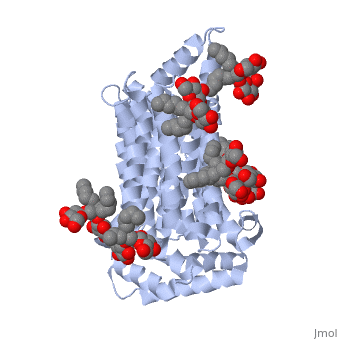Sandbox Reserved 1329
From Proteopedia
(Difference between revisions)
| Line 6: | Line 6: | ||
== Function == | == Function == | ||
The primary biological function of this protein is for glucose transmembrane transport, or the transport of glucose molecules over the plasma membrane. Using the Michaelis-Mentin Kinetics Model, the GLUT3 mediated transport of glucose had a higher affinity during the outward substrate binding site. Secondly, the transport occurs more efficiently and quickly when the substrate is present on the trans site of the membrane. | The primary biological function of this protein is for glucose transmembrane transport, or the transport of glucose molecules over the plasma membrane. Using the Michaelis-Mentin Kinetics Model, the GLUT3 mediated transport of glucose had a higher affinity during the outward substrate binding site. Secondly, the transport occurs more efficiently and quickly when the substrate is present on the trans site of the membrane. | ||
| + | |||
| + | == Disease == | ||
| + | Current research has made insights in to the structure of GLUT3, allowing for investigations into variable expression resulting in association with disease processes. Certain GLUT proteins, such as GLUT1 and GLUT3, has increased expression in cancer cells. Analyzing the variation in expression patterns within this protein has been used as a diagnostic tool, and in certain cases it can be used as an imaging tool in oncology. Lastly, there are currently investigations into the applications of GLUT as a drug delivery mechanism due to its binding and conformation properties. | ||
== Relevance == | == Relevance == | ||
Revision as of 19:20, 27 February 2018
| This Sandbox is Reserved from January through July 31, 2018 for use in the course HLSC322: Principles of Genetics and Genomics taught by Genevieve Houston-Ludlam at the University of Maryland, College Park, USA. This reservation includes Sandbox Reserved 1311 through Sandbox Reserved 1430. |
To get started:
More help: Help:Editing |
Human Glucose Transporter GLUT3/SLC2A3
| |||||||||||
References
https://www.ncbi.nlm.nih.gov/pubmed/19690067
https://www.ncbi.nlm.nih.gov/books/NBK6545/
https://www.ncbi.nlm.nih.gov/pmc/articles/PMC4104978/
Carruthers A, DeZutter J, Ganguly A, Devaskar SU. Will the original glucose transporter isoform please stand up! Am J Physiol Endocrinol Metab. 2009;297(4):E836-848.

